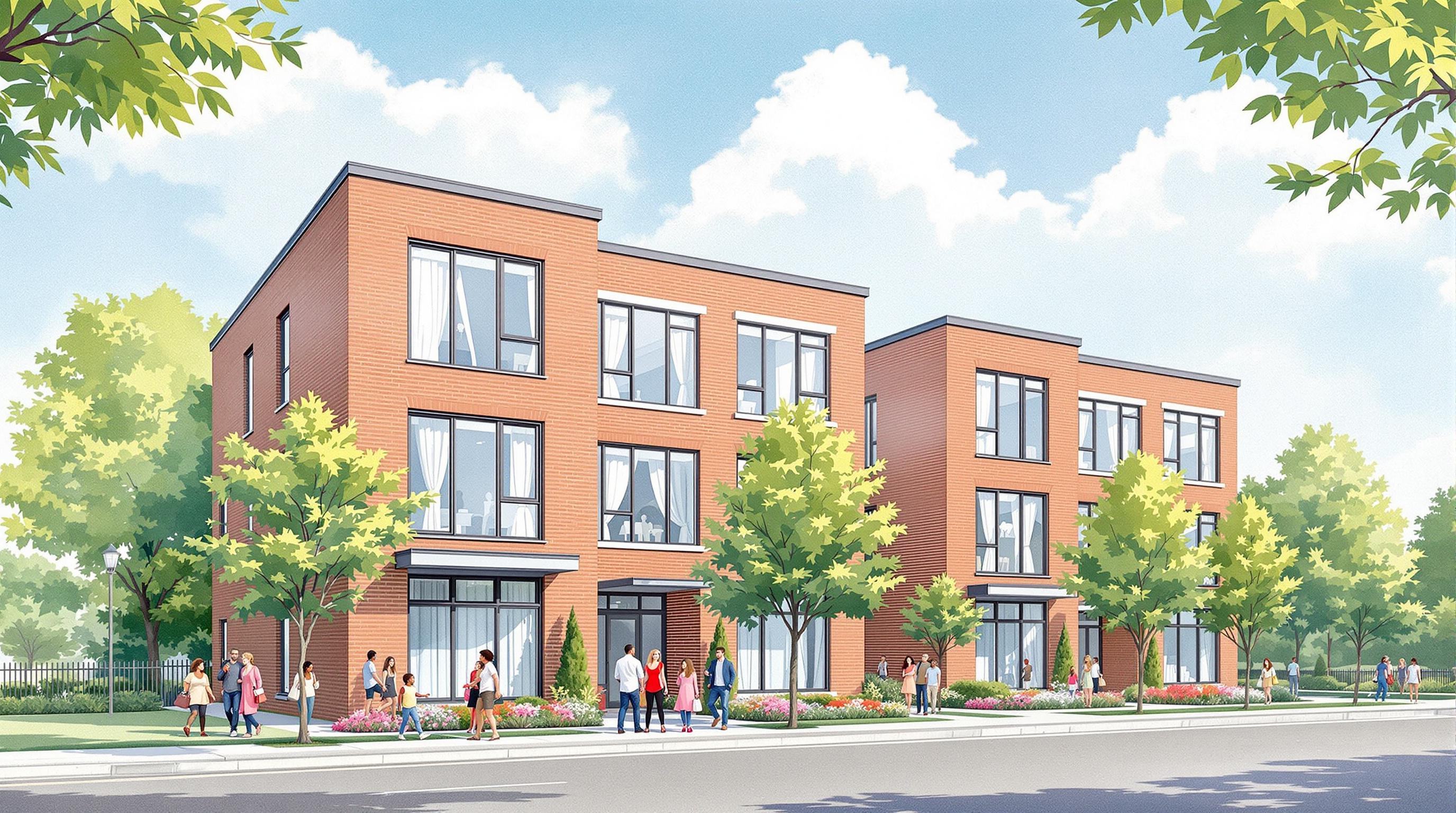Lancaster faces an affordable housing crisis, with only 19 affordable units available for every 100 households in need. Tax credits, especially through the Low-Income Housing Tax Credit (LIHTC) program, are helping bridge this gap by funding projects that create affordable homes and stimulate local economic growth.
Key Highlights:
- LIHTC Program: Covers 40%-70% of development costs, enabling lower rents.
- Major Projects: $1.25M in tax credits helped create 118 affordable units in 2021.
- Community Impact: 200 construction jobs, 15 permanent roles, and better long-term housing stability.
- Challenges: High competition for tax credits and limited funding availability.
- Solutions: Blending federal, state, and local funds, and leveraging public-private partnerships.
Tax credits are crucial for addressing Lancaster's housing shortage and improving access to affordable, long-term housing solutions.
What Is the Low Income Housing Tax Credit?
Low-Income Housing Tax Credits (LIHTC) Explained
The Low-Income Housing Tax Credit (LIHTC) is the federal government’s main tool for supporting the development of affordable housing.
How LIHTC Benefits Developers
LIHTC provides developers with a direct way to reduce federal tax bills. These tax credits, when sold to investors, can cover 40% to 70% of a project’s development costs [1]. This large equity contribution reduces the need for loans, allowing developers to charge lower rents while keeping their projects financially viable.
| Credit Type | Subsidy Level | Typical Use Cases |
|---|---|---|
| 9% Credits | Around 70% of costs | New construction without other federal subsidies |
| 4% Credits | Around 30% of costs | Rehab projects or new construction with additional federal funding |
Program Rules and Requirements
To qualify for LIHTC in Pennsylvania, projects must meet strict guidelines to ensure affordability over time.
Income and Rent Guidelines
- At least 20% of the units must be set aside for households earning 50% or less of the Area Median Income (AMI), or 40% for those earning 60% or less of AMI [3].
- Rent for these units cannot exceed 30% of the income limit set for qualifying households [3].
Commitment to Long-Term Affordability
Developers must ensure affordability for at least 30 years. This includes a 15-year initial compliance period, followed by a 15-year extended use period [3]. These rules help preserve affordable housing options in Lancaster for decades.
High Construction and Design Standards
Projects must meet tough requirements for construction quality, energy efficiency, and zoning [3]. These measures ensure the housing integrates well into neighborhoods and meets modern standards.
In addition, state programs like PennHOMES offer 0%-interest loans to support these projects. The next section will look at how these funding strategies are applied in Lancaster.
Tax Credit Projects in Lancaster
Lancaster is putting Pennsylvania's funding programs to work by focusing tax credit investments on areas with the potential for the biggest impact. The city's use of Low-Income Housing Tax Credits (LIHTC) has led to its first multi-family affordable housing projects in decades, addressing critical housing needs.
Focused Development Areas
The city is concentrating on locations with strong infrastructure and good transit options. One standout project is the redevelopment of the former St. Joseph's Hospital site, made possible with LIHTC funding. This site is a centerpiece of Lancaster's redevelopment plans. Additionally, areas along the city-township border are being developed to serve both urban and suburban communities. The Marietta Avenue area is also under consideration for expansion, with plans for 46-50 new housing units supported by American Rescue Plan Act funding.
Here’s a snapshot of the key development zones:
| Development Area | Key Benefits | Phase |
|---|---|---|
| St. Joseph's Hospital Site | Utilizes existing infrastructure, offers urban amenities | First phase approved |
| City-Township Border | Benefits both urban and suburban populations | Development ongoing |
| Marietta Avenue Area | Potential for 46-50 additional units | Under consideration |
The Apartments at College Avenue Project
The $15.4 million College Avenue development, led by HDC Mid-Atlantic, is a prime example of LIHTC's impact. This project is the first phase of redeveloping the St. Joseph's Hospital site. Another notable effort is Community Basics' Bausman Place Apartments, which created 54 units with the help of a $525,000 PennHOMES loan. Both projects show how tax credits can breathe new life into underused urban areas [1].
sbb-itb-7fa5722
Community Impact of Tax Credit Housing
Tax credit housing offers more than a roof over people’s heads - it brings wide-reaching benefits to the community.
Local Jobs and Business Growth
Tax credit housing projects give Lancaster’s economy a boost by creating jobs and driving business activity. Recent developments have led to 200 construction jobs and 15 permanent roles in property management and maintenance [1].
Here’s how the numbers stack up:
| Economic Impact per $1M Invested | Jobs Created |
|---|---|
| Per $1M invested | 11-15 new jobs [1] |
| Construction Phase | Employs local contractors |
| Operational Phase | Adds permanent staff positions |
By placing these projects in key areas, business districts benefit from increased foot traffic and opportunities for local contractors [1].
Social and Health Outcomes
These projects go beyond addressing Lancaster’s lack of small-unit housing - they ensure affordability for 55 years, which is 25 years longer than federal requirements [1]. This long-term commitment tackles Lancaster’s significant housing gap, where only 19 affordable units exist for every 100 households in need, compared to Pennsylvania’s average of 42 per 100 [2].
The benefits don’t stop at housing. Stable homes supported by tax credits are linked to 20-30% higher graduation rates for children. These projects lay the groundwork for healthier, more connected neighborhoods while addressing Lancaster’s pressing housing challenges.
Current Issues and Solutions
Tax credits have supported key projects like those at College Avenue and Bausman Place, but Lancaster continues to grapple with systemic obstacles. Even with achievements like the St. Joseph's Hospital redevelopment, challenges remain.
Tax Credit Demand vs. Supply
The demand for tax credits in Lancaster far outweighs the available supply, forcing developers into fierce competition for limited allocations.
Developers face several hurdles in this process:
- High Competition: Limited funding means only a fraction of qualified projects secure tax credits.
- Complex Financing Needs: Projects often require multiple funding sources to proceed.
- Income Restrictions: Housing units must cater to families earning 50-60% of the Area Median Income [4].
Potential Improvements to State Programs
Pennsylvania is taking steps to improve the effectiveness of tax credits. One key initiative is a new state law offering 10-year tax abatements in areas with distressed properties, provided 30% of the housing is affordable for households earning 60% of the area median income [2].
Lancaster is addressing these challenges with several strategies:
- Blending Federal, State, and Local Funds: Combining resources to stretch the impact of each dollar.
- Using Pandemic Recovery Funds: Leveraging federal relief money for housing projects.
- Boosting Public-Private Partnerships: Collaborating with private entities to create new funding opportunities.
These combined efforts help Lancaster make the most of tax credit funding, while state and local initiatives aim to improve affordability and ensure long-term housing solutions.
Local Real Estate Support Systems
Lancaster's approach to affordable housing thrives on collaboration between real estate professionals and community organizations. These partnerships play a key role in making the most of tax credits and improving access to housing.
Developer and Nonprofit Partnerships
Tax credit-funded housing projects in Lancaster owe their success to teamwork between developers and nonprofit groups. Organizations like HDC Mid-Atlantic and Community Basics Inc. combine their strengths to make these projects work. Developers focus on construction expertise, while nonprofits bring a deep understanding of community needs and access to funding. Together, they create a system where:
- Developers handle construction and project execution.
- Nonprofits contribute community knowledge and help secure funding.
Housing Access Services
Local firms like Central PA Realty connect tax credit housing developments with the residents who need them most. They assist by offering property searches for income-qualified individuals, explaining eligibility requirements, and working with property managers to ensure affordability standards are met.
Banks also play a critical role by offering financial products designed for these projects, such as:
- Construction loans tailored for affordable housing.
- Investments in Low-Income Housing Tax Credits (LIHTC).
- Mortgage products adjusted to fit different income levels.
This network of coordinated efforts ensures that tax credit investments lead directly to accessible and lasting housing solutions, strengthening Lancaster's housing support system.
Conclusion
Tax credits have played a key role in Lancaster's efforts to expand affordable housing, providing much-needed homes while also stimulating the local economy through job creation and investment.
In 2022, Pennsylvania allocated $44.2 million in LIHTC funding, helping to support Lancaster’s approach to affordable housing development. By prioritizing one- and two-bedroom apartments, the city is addressing a critical housing need [1]. This targeted strategy has laid the groundwork for continued progress in meeting housing demands.
To tackle the ongoing gap between housing demand and supply, Lancaster must stay focused on key development areas, such as the former St. Joseph's Hospital campus. Achieving this will depend on strengthening public-private partnerships and identifying additional funding sources to build on current programs [5]. Lancaster’s efforts show how tax credits can expand housing access while aligning with broader community goals.


